Snowmobiles Switched At Birth
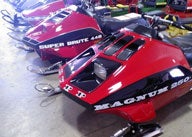
Vintage event showcases how the global economy works in the world of snowmobiling
If you attended the ever-popular Waconia (MN) vintage snowmobile event at the end of January, you would have seen a host of Scorpion snowmobiles, which were the “featured” brand for this season. Next season Yamaha gets to be the star. But this season it was all Scorpion. Sort of!
While Scorpion grew out of the Trail-A-Sled brand that was founded in 1959, there were periods where Scorpion produced models for other brands and then in 1978 it, too, became part of another manufacturer, Arctic Cat.
One the interesting things about snowmobiling back in the day – circa 1950 to the 1970s – was that sometimes one snowmobile manufacturer would make sleds or models for other brands. This actually started with Polaris in the mid-1950s when it “private-labeled” sleds for sale into Canada. Built in Roseau for Canadian entrepreneur H. C. “Harry” Paul, these sleds carried different paint than the red Polaris Sno-Traveler and were sold in western Canada under the Autoboggan label.
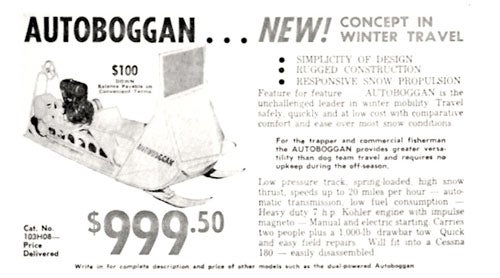 In the mid-1950s Polaris’ Sno-Traveler was sold in western Canada as the Autoboggan.
In the mid-1950s Polaris’ Sno-Traveler was sold in western Canada as the Autoboggan.Following the rush of snowmobile successes into the early 1970s, many brands got swallowed up by conglomerates looking to cash in on the booming market, expected to reach one-million sales in those heady early days. In 1969 Trail-A-Sled became part of Fuqua Industries, which was based in Georgia and had little practical knowledge of snowmobiling. The change in ownership resulted in a name change to Scorpion, Inc.
As most vintage Scorpion snowmobilers know, Fuqua’s involvement lasted only until 1973, when the company was salvaged by an under-capitalized group of Scorpion management, which took over control in an effort to ride out a severe downturn in the snowmobile market caused by a deadly combination of poor snow seasons and a worldwide recession. Sounds a bit familiar.
During this short-term of management prior to the sale to Arctic Cat, Scorpion managers were both busy and innovative, securing an engine supply, a contract customer and purchasing a rival company. 1974 held promise as Scorpion developed its Cuyuna engines as well as acquired rights to Brutanza, makers of the innovative Brut snowmobiles. More importantly, the Crosby, Minn., sled maker secured a deal with Canadian tractor maker Massey-Ferguson to produce its snowmobile line.
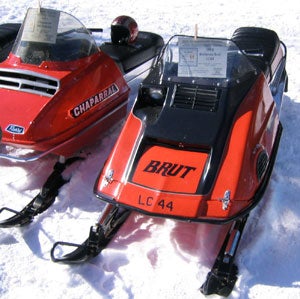 Scorpion bought Brutanza Brut, which enjoyed a performance image from which Scorpion hoped to benefit. A Massey Ferguson version based on later Scorpion Brut models carried the name Cyclone.
Scorpion bought Brutanza Brut, which enjoyed a performance image from which Scorpion hoped to benefit. A Massey Ferguson version based on later Scorpion Brut models carried the name Cyclone.This proved a short-term deal, but it delivered added production and business that couldn’t have added much to the per-unit cost of Scorpion sleds at the time. Essentially, like the Autoboggans of the 1950s, the new mid-1970s Massey-Ferguson snowmobiles were Scorpions with different paint, graphics and nomenclature.
Scorpion had its own brand identity and model names so Massey-Ferguson gained a hip, new style when it came to market with the entry-priced 294cc Chinook, two versions of the mass appeal Whirlwind and both a 340cc and 440cc liquid-cooled Cyclone, based on the Brut performance line acquired the year before. Massey-Ferguson snowmobile group touted this new evolution with full-page advertisements introducing the new breed of sleds.
You need to remember that while Scorpion’s lifeblood centered on an infusion of successful sleds, Massey Ferguson’s agricultural business kept it profitable and sleds were commonly heavily discounted to buyers of their combines and harvesters.
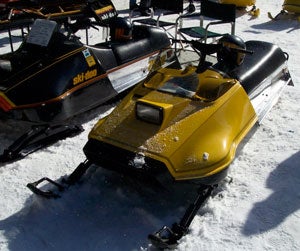 When this Ski-Doo was new there were orange versions bearing the Moto-Ski brand name.
When this Ski-Doo was new there were orange versions bearing the Moto-Ski brand name.As time moved on in the snowmobile business, experiments like the one between Scorpion and Massey Ferguson continued, generally unsuccessfully for one of the partners. Once Massey ended its snowmobile business, Scorpion struggled, eventually moving into Arctic Cat, which had problems of its own that resulted in a closing of the Scorpion facilities, which were put up for sale as Arctic Cat tried to thwart its own filing for bankruptcy in 1981.
Long-term brands worked with one another or ended up in a consolidation. Ski-Doo would take on Moto-Ski, which had been a serious rival in Quebec. Indeed, Moto-Skis eventually became orange Ski-Doos in an attempt to appeal to long time Moto-Ski owners. It seemed to work for a short time, but economics made it senseless for the premier Bombardier brand to continue distinct and separate dealer networks.
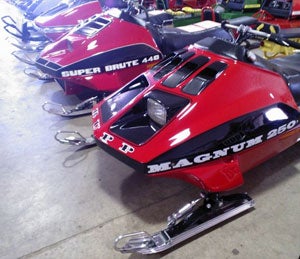 The Alouette’s resemblance to the Rupp in the background was deliberate thanks to a merger of the brands.
The Alouette’s resemblance to the Rupp in the background was deliberate thanks to a merger of the brands.Other French-Canada born brands suffered despair in the 1970s. By model year 1976 Alouette brand snowmobiles went from innovations like the twin-tracked racer driven by Gilles Villeneuve to engineering, style and marketing from Rupp, which took over the brand in an effort to keep itself in business. That would fail.
When it came to truly switched at birth sleds, the best twosome had to be Johnson and Evinrude, manufactured by Outboard Marine. For this company, having essentially the same snowmobiles sold under two different brand names meant a continuation of its outboard engine philosophy. Like Mercury, these sleds grew out of finding another usage for in-house engines. Of course, by the mid-1970s, Mercury would derive power for its Trail Twisters and race-winning Twisters from Kohler and not the reliable but performance-deficient Mercury engines of earlier models.
While outright manufacture of one sled brand by another sled company went on, there was another way for one sled company to help itself. One of the oddest snowmobile marriages we can recall involved Kawasaki.
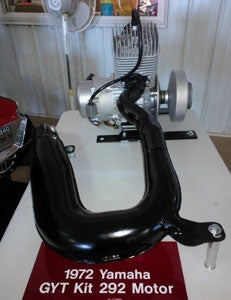 Yamaha’s 292cc single scored wins in Thunder Jet chassis and was available with a “performance” kit that included the tuned exhaust.
Yamaha’s 292cc single scored wins in Thunder Jet chassis and was available with a “performance” kit that included the tuned exhaust.Prior to the arrival of Suzuki as engine supplier to Arctic Cat, Kawasaki powered many Cats of the era. The popular El Tigre 440 gained quite a performance reputation with its dual-sparkplug head. But, with Suzuki on board, Kawasaki looked for another entrance back into the sport. Enter Sno-Jet, which Kawasaki purchased and for a very short time had Arctic Cat build at its plant in Thief River Falls, Minn. Some of those highest performing Kawasaki Sno-Jets featured Yamaha engines!
Yamaha had supplied engines to the Vermont-built Sno-Jets and it was Yamaha power that gave the Thunder-Jet oval racers their successes. But, this couldn’t last and Kawasaki rode out the Sno-Jet years before bringing its own innovative Kawasaki-branded and Kawasaki-powered models to market. It does make an interesting footnote in the history of the sport and a potential trivia-winning bet for bench racing discussions.
Supplying engines to Sno-Jet gave Yamaha an added source of revenue in addition to building a line of its own branded snowmobiles. Along with Sno-Jet, Yamaha supplied power to the Saskatchewan-based Roll-o-flex brand snowmobiles. In the early days of the sport, sourced engines came from all over the world – Japan, Germany, Austria, Canada and the United States. Partnerships proved common, much like we see today in automobiles, outboard engines, mopeds, motorcycles and such. Can you believe that some of today’s brand-identified outboard motors were not actually built by the logo on the outer case? It’s very prevalent in the smallish four-stroke outboard market.
The point is that what vintage sled enthusiasts saw at Waconia’s Scorpion showcase highlighted a unique period in snowmobile history and presented a view of what modern day manufacturing has become in a global marketplace. Snowmobiling got there first. Ask Polaris, Arctic Cat, Ski-Doo and Yamaha. They’ve all had snowmobile ventures in the global marketplace almost since the very beginning.
Related Reading 10 Great Ideas in Snowmobile History Choosing A Vintage Racer What’s Old Is New Again 7 Things Modern Sledders Won’t Need to Worry About Why Modern Sleds Cost More Evolution of Snowmobile Front Suspensions Bassett’s Blog : Vintage Sleds A Threat?



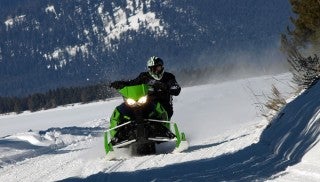
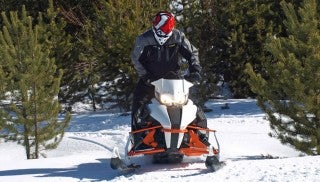



 Your Privacy Choices
Your Privacy Choices